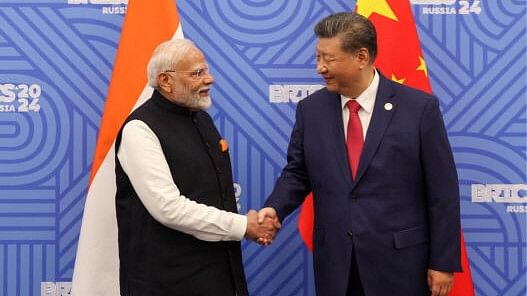
Indian Prime Minister Narendra Modi shakes hands with Chinese President Xi Jinping before their meeting on the sidelines of the BRICS summit in Kazan, Russia
Credit: India's Press Information Bureau/Handout via Reuters
The meeting between Prime Minister Narendra Modi and Chinese President Xi Jinping on Wednesday on the sidelines of the 16th BRICS summit in Kazan – capital of the Republic of Tatarstan, Russia – was the first formal bilateral talk between the two leaders in five years. The military stand-off along the Line of Actual Control (LAC) in eastern Ladakh since April-May 2020 had brought the relations to a new low. The stage for the meeting was set over the past several weeks, as diplomats and military negotiators from the two sides worked out an arrangement for patrolling in Depsang and Demchok, the last two LAC points where the stand-off persisted even after mutual disengagement of frontline troops.
Though not many details about the latest agreement have been made available, External Affairs Minister S Jaishankar said the agreement would allow the Indian Army to patrol the area as it had been doing till 2020 when the Chinese PLA blocked access to several patrolling points. The return to the pre-2020 patrolling pattern is, undoubtedly, significant as India would now be able to better guard its strategic Daulat Beg Oldie military base as well as the access to Karakoram Pass against potential aggression by China.
But the threat of China resorting to its salami-slicing strategy persists. What Foreign Secretary Vikram Misri told journalists about the latest agreement made it clear that it would not end the moratorium on patrolling that India and China agreed upon in Galwan Valley and on the northern bank of Pangong Tso. It would also not do away with similar ‘buffer zones’ created while mutually pulling out troops from Gogra Post and Hot Springs areas in 2021 and 2022.
Unless the Indian Army’s pre-2020 patrolling pattern is restored all along the LAC, the Chinese PLA will continue to have an edge. New Delhi should reassure the nation that Beijing cannot impose a new normal along the disputed border. When Modi hosted Xi on the banks of the Sabarmati in September 2014, the Indian Army was engaged in a stand-off at Chumar, along the LAC, in Ladakh. Less than a year after the June-August 2017 stand-off in Doklam Plateau in western Bhutan strained the ties, the two leaders had an ‘informal’ meeting at Wuhan in China. This was followed by a sequel at Mamallapuram near Chennai, in October 2019. ‘Wuhan Spirit’ and ‘Chennai Connect’ disappeared into the thin air of the Himalayas after the Indian Army and the Chinese PLA soldiers engaged in a violent clash in Galwan Valley in June, 2020, taking to the flashpoint the military stand-off, which then continued for more than four years. How long will the ‘Tatarstan Thaw’ last? New Delhi should not let Beijing decide this time around.